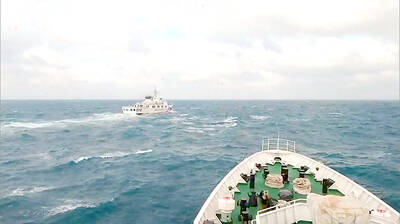For the indigenous peoples of Taiwan, the unemployment rate is more than just another government statistic. It's part of their daily life. And it's almost three times higher than that of the Han population.
According to a poll released yesterday by the Council of Aboriginal Affairs, the unemployment rate among indigenous people is 7.55 percent -- approximately three times that of the rest of the population.
The poll was conducted by the Taiwan Survey Service (
The average unemployment rate for that month was 2.84 percent.
Of the 287,162 people from Taiwan's indigenous tribes above 15 years of age -- who constitute 1.7 percent of the island's total population in that age group -- 195,502, or 68 percent, are eligible for work, the poll indicated.
However, among the 195,502 people, a total of 14,757, or 7.55 percent, were unemployed.
Chiu Ju-na (
Chiu pointed out that since the majority of indigenous people have worked as laborers in the construction industry and are accustomed to high pay for short periods of time, they are not interested in jobs that offer lower salaries.
"They hope to make at least NT$3,000 per day, but the present market doesn't offer so high a rate due to the current economic slowdown," Chiu said. "Many of them won't accept a lower offer and choose instead to return to their hometowns."
Chiu said that since a majority of indigenous people don't have higher education credentials, their job competitiveness is weakened and their job options are limited.
The poll indicated that only nine percent of the population of indigenous people above 15 are college graduates.
The poll also indicated that 30 percent are high school graduates, 22 percent are junior high school graduates and 31 percent completed elementary school only.
Regarding cultural factors behind the high unemployment rate, Chiu said that many indigenous people do not enjoy working independently in industrial and commercial professions because it has long been a tribal custom to work in groups.
Chiu said that another reason for the high unemployment rate is competition from foreign workers. Chiu noted that 41 percent of laborers from the island's indigenous tribes work in technical, semi-technical and labor-intensive professions -- the same fields foreign workers are in.
According to statistics from the Directorate General of Budget, Accounting and Statistics, while the number of foreign workers working in major construction projects increased by 7,896 people in 1998, the number of indigenous people working in the same field decreased by approximately 1,000 people during the same period.
Council chairman Hua Chia-chih (
Hua pointed out that while there are about 3,600 jobs available every month, only about 1,300 job seekers from indigenous tribes come in for job assistance.
"There are job openings, but they aren't filled probably because they require workers to live far away from their hometowns or because the pay is too low," Hua said.

Conflict with Taiwan could leave China with “massive economic disruption, catastrophic military losses, significant social unrest, and devastating sanctions,” a US think tank said in a report released on Monday. The German Marshall Fund released a report titled If China Attacks Taiwan: The Consequences for China of “Minor Conflict” and “Major War” Scenarios. The report details the “massive” economic, military, social and international costs to China in the event of a minor conflict or major war with Taiwan, estimating that the Chinese People’s Liberation Army (PLA) could sustain losses of more than half of its active-duty ground forces, including 100,000 troops. Understanding Chinese

The Ministry of Foreign Affairs (MOFA) yesterday said it is closely monitoring developments in Venezuela, and would continue to cooperate with democratic allies and work together for regional and global security, stability, and prosperity. The remarks came after the US on Saturday launched a series of airstrikes in Venezuela and kidnapped Venezuelan President Nicolas Maduro, who was later flown to New York along with his wife. The pair face US charges related to drug trafficking and alleged cooperation with gangs designated as terrorist organizations. Maduro has denied the allegations. The ministry said that it is closely monitoring the political and economic situation

‘SLICING METHOD’: In the event of a blockade, the China Coast Guard would intercept Taiwanese ships while its navy would seek to deter foreign intervention China’s military drills around Taiwan this week signaled potential strategies to cut the nation off from energy supplies and foreign military assistance, a US think tank report said. The Chinese People’s Liberation Army (PLA) conducted what it called “Justice Mission 2025” exercises from Monday to Tuesday in five maritime zones and airspace around Taiwan, calling them a warning to “Taiwanese independence” forces. In a report released on Wednesday, the Institute for the Study of War said the exercises effectively simulated blocking shipping routes to major port cities, including Kaohsiung, Keelung and Hualien. Taiwan would be highly vulnerable under such a blockade, because it

UNRELENTING: China attempted cyberattacks on Taiwan’s critical infrastructure 2.63 million times per day last year, up from 1.23 million in 2023, the NSB said China’s cyberarmy has long engaged in cyberattacks against Taiwan’s critical infrastructure, employing diverse and evolving tactics, the National Security Bureau (NSB) said yesterday, adding that cyberattacks on critical energy infrastructure last year increased 10-fold compared with the previous year. The NSB yesterday released a report titled Analysis on China’s Cyber Threats to Taiwan’s Critical Infrastructure in 2025, outlining the number of cyberattacks, major tactics and hacker groups. Taiwan’s national intelligence community identified a large number of cybersecurity incidents last year, the bureau said in a statement. China’s cyberarmy last year launched an average of 2.63 million intrusion attempts per day targeting Taiwan’s critical